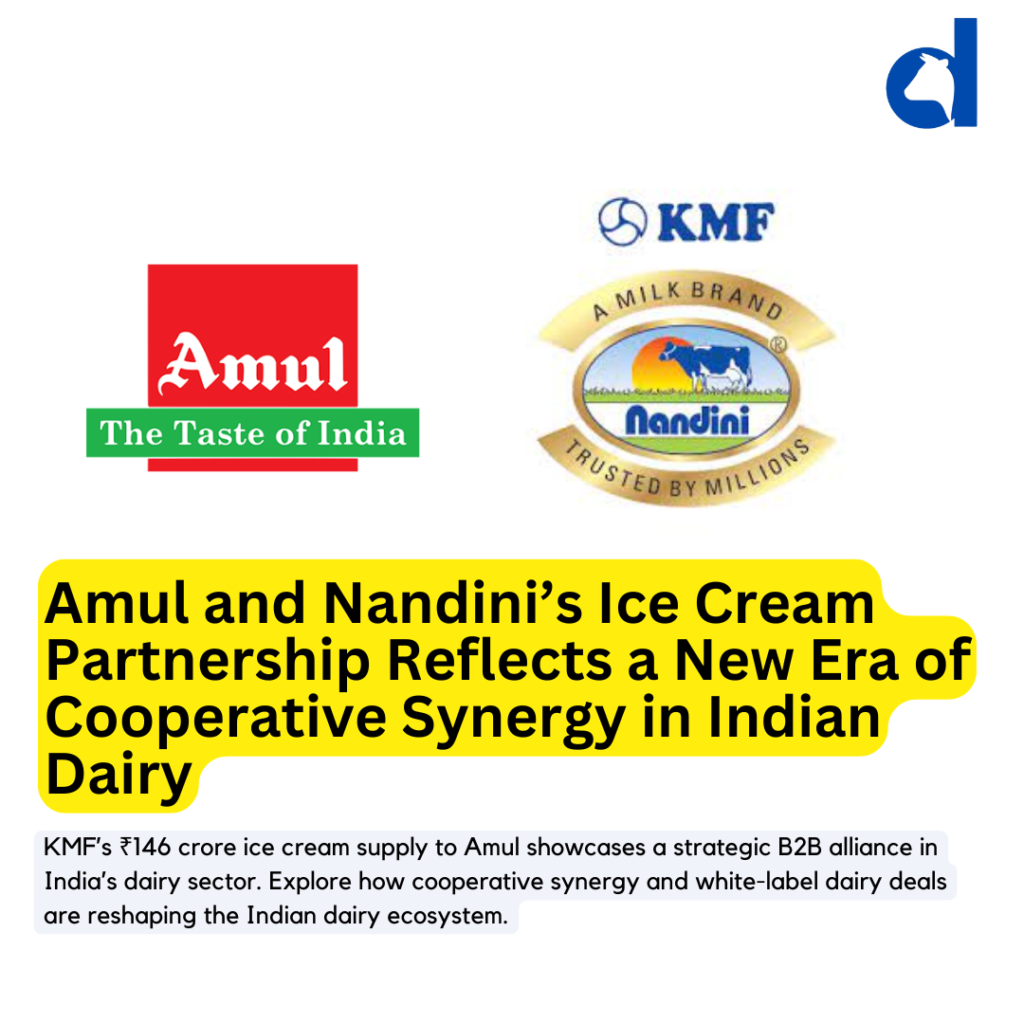In a significant yet often overlooked example of inter-cooperative collaboration, the Karnataka Milk Federation (KMF), known for its popular Nandini brand, has quietly emerged as a key supplier of ice cream to Gujarat-based dairy giant Amul, run by the Gujarat Cooperative Milk Marketing Federation (GCMMF).
Between 2022 and 2025, KMF supplied nearly 12,000 litres of ice cream per day to Amul, culminating in a cumulative revenue of ₹146 crore and a net profit of ₹3.7 crore. This white-label arrangement, wherein Amul marketed and distributed the product under its own label, despite it being manufactured by KMF, challenges the popular narrative of rivalry between the two cooperatives and instead highlights the untapped potential of synergistic cooperation in India’s dairy ecosystem.
“When India’s top dairy cooperatives collaborate instead of compete, the result is scale without conflict, efficiency without redundancy,” says Dr. Shyam Mehta, an agribusiness analyst and cooperative sector expert.
A Story Beyond Numbers: The Power of Cooperative Synergy
This type of white-label cooperation between dairy cooperatives—such as KMF supplying ice cream to Amul—is driven by the need for operational efficiency, capacity optimisation, and faster market responsiveness. Instead of investing in new production infrastructure in every region, cooperatives leverage each other’s existing processing facilities to reduce costs, cut transportation time, and maintain product quality. It also helps meet regional demand surges without disrupting supply chains. For cooperatives like KMF, it offers an additional revenue stream by monetising surplus capacity, while brands like Amul benefit from local production and quicker distribution. This approach reflects a mature and strategic shift in the Indian dairy industry, where collaboration enhances competitiveness.
This business arrangement underscores how India’s federated dairy structure—based on the Amul model of three-tier cooperative systems—can foster not only grassroots empowerment but also interstate operational alliances. For instance:
-
B2B Collaboration over Brand Clashes: While political and public discourse in Karnataka previously projected Amul’s expansion into the state as a threat to Nandini, the reality on the ground shows a different picture—Amul relying on Nandini’s manufacturing strength in the South to meet regional demand efficiently.
-
Temple Trust Partnerships: In FY 2024–25 alone, KMF supplied 4,520 tonnes of ghee to the Tirumala Tirupati Devasthanam (TTD) in Andhra Pradesh—despite this temple being geographically and culturally outside Karnataka’s usual dairy consumer base. This is yet another instance where logistics, quality assurance, and institutional trust took precedence over state lines.
White-Label Dairy Supply: Growing Practice in the Indian Market
With this KMF-Amul case garnering attention due to its high volume and emotional geography (two brand powerhouses from different states), it’s an isolated example. White-label dairy operations and cross-cooperative partnerships are quietly growing across India, including:
- Mother Dairy and Regional Private Labels: Mother Dairy, operated by the National Dairy Development Board (NDDB), has been sourcing paneer and curd from regional private processors in Maharashtra and Tamil Nadu to ensure rapid product replenishment under its own label in Tier-2 cities.
- Verka Supplying SMP to Eastern StatesPunjab’s’s Verka brand, managed by MILKFED, has supplied skimmed milk powder (SMP) and packaged milk to cooperatives in West Bengal and Bihar during seasonal procurement shortfallsAmul’s’s Whey Procurement from Smaller Dairies: In Gujarat, Amul has started integrating whey and byproducts sourced from smaller cooperatives for its bioethanol and nutrition supplement divisions, reflecting a new wave of ingredient-level cooperation rather than complete product branding.
Cooperative Strategy or Future Blueprint?
This cooperative interplay is not only a smart logistics and scale strategy, but also a solution to India’s fragmented cold chain and supply chain limitations. Regional federations often have excess production capacities, while national players carry brand heft and distribution channels.
Industry insiders suggest that such co-manufacturing and white-labelling models can help:
- Avoid redundant capital expenditure on new plants.
- Maintain supply continuity amid regional demand spikes.
- Allow cooperatives to monetise their surplus while maintaining consistent farmer payments.
“The future of India’s dairy sector lies in functional integration rather than brand isolation,” notes Devanshi Patel, Dairy Supply Chain Head at a leading FMCG firm.
Challenges and the Way Forward
Despite the clear benefits, such collaborations face bottlenecks:
- Lack of centralized matchmaking platforms for B2B dairy partnerships.
- Brand sensitivities that hinder transparency around white-label sourcing.
- Political overtones that often complicate cooperative-level negotiations.
To address this, experts recommend establishing a national cooperative synergy cell under the NDDB to facilitate neutral, efficiency-driven partnerships across states.
Conclusion
In an era where the Indian dairy industry is poised to cross ₹15 lakh crore in value by 2030, such examples of cooperative synergy—as seen between Amul and Nandini—are not just business deals but a prototype of a sustainable dairy framework that can scale sustainably. As cooperatives explore newer formats like D2C ecommerce, value-added exports, and climate-friendly dairying, working together may no longer be optional—it may be essential.
